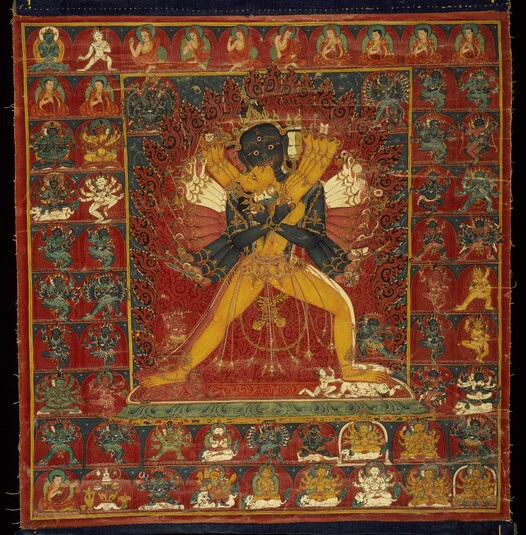
Item: Kalachakra (Buddhist Deity)
| Origin Location | Central Tibet |
|---|---|
| Date Range | 1300 - 1399 |
| Lineages | Sakya |
| Size | 53.20x51.30cm (20.94x20.20in) |
| Material | Ground Mineral Pigment on Cotton |
| Collection | Museum of Fine Arts, Boston |
| Catalogue # | acc.#67 821, Gift of John Goelet |
Classification: Deity
Shri Kalachakra (Tibetan: pal du kyi kor lo. English: the Wheel of Time) and the Vajravali cycle of deities according to the text of Abhayakaragupta. (See a Vajrakila painting with a similar composition, colour palette and date).
Video: Kalachakra HAR #87223
This is the only known painting where all of the deities described in the Vajravali are depicted in a single composition. It is also likely to be the earliest Tibetan painting of the subject making it the most important single artwork in the study of the Vajravali literature and subsequent works of art. (See the chapter on the history of the Vajravali in the Blue Annals by Go Lotsawa).
Sanskrit: Kalachakra Tibetan: Du kyi kor lo
Tibetan: Du kyi kor lo
Semi-wrathful in appearance, blue in colour, he has four faces, twenty-four hands and two legs. The main face is blue, right red, left white and the back face is yellow. Each has three eyes and an open mouth with slightly bared fangs. The first set of eight hands are blue in colour, second (middle) red and third (upper) yellow. The first pair of hands hold a vajra and bell crossed at the heart embracing the consort. The remaining right hands hold a sword, curved knife, trident, three arrows, vajra hook, hand drum (damaru), hammer, wheel, spear, club and axe. The left hands hold a shield, katvanga staff, skullcup, bow, lasso, jewel, lotus, conch shell, mirror, vajra chains and the four-faced yellow head of Brahma. The consort, Vishvamata, is yellow, with four faces and eight hands. They are both adorned with crowns, necklaces, earrings, bracelets and various ornaments. The right leg of the Lord is straight and red, standing atop the figure of red Kamadeva. The left is bent and white, standing atop white Rudra. Above a red sun disc they stand on a lotus blossom seat wreathed by the red flames of the fires of pristine awareness.
At the center of the composition is the complex meditational deity Kalachakra. To the upper right of the central figure is Shri Hevajra, lower right Mahachakra Vajrapani, lower left Rakta Yamari and upper left Vajrabhairava.
Beginning at the viewer's top left is the primordial Buddha Vajradhara, white Vajrayogini Jnana Dakini and then four Indian Panditas: Abhayakaragupta, and what is likely to be Punyakaragupta, Lon Shab, Kirtichandra, followed possibly by the Tibetan translator Dragpa Gyaltsen or Chag Lotsawa. Both of these Tibetan teachers were important early propagators of the Vajravali system. Following that are three more Tibetan teachers (in the same top register) and then two more in the register below on the left side for a total of six.
Lineage: Vajradhara, Jnana Dakini, Abhayakaragupta, Anusama Rakshita, Vikhyata Deva, Kache Shakya Shribhadra, Pandita Bhumishri, Vimalashri, Bodhi Sidha, Kyiton Jamyang Dragpa Gyaltsen, Dolpo Sherab Gyaltsen, Sazang Panchen Lodro Gyaltsen, Sazang Pagpa Shonnu Lodro, Ngorchen Vajradhara Kunga Zangpo, etc. (See alternate lineages of the Vajravali and Kriya-samucchaya).
View Identification Key: 1. Kalachakra, 2. Hevajra, 3. Mahachakra Vajrapani, 4. Rakta Yamari, 5. Vajrabhairava, 6. Vajradhara, 7. Jnana Dakini, 8. Abhayakaragupta, 9. Punyakaragupta, 10. Lon Shab, 11. Kirtichandra, 12. Dragpa Gyaltsen or Chag Lotsawa, 13. Tibetan Teacher, 14. Tibetan Teacher, 15. Tibetan Teacher, 16. Tibetan Teacher, 17. Tibetan Teacher, 18. Hevajra (Two Arms), 19. Hevajra (Four Arms), 20. Akshobhyavajra Guhyasamaja, 21. Manjuvajra Guhyasamaja, 22. Hevajra (Six Arms), 23. Mahamaya, 24. Jnana Dakini, 25. Samputa Vajrasattva, 26. Heruka Buddha Kapala, 27. Humkara, 28. Hevajra (Two Armed, Samputa), 29. Hevajra (Four Armed, Samputa), 30. Sahaja Heruka Chakrasamvara, 31. Chakrasamvara, 32. Hevajra (Six Armed, Samputa), 33. Shastradhara Hevajra (Sixteen Arms, Weapon Holding, Samputa), 34. Vajravarahi, 35. Pita Chakrasamvara, 36. Nairatmya (Two Arms), 37. Nairatmya (Four Arms), 38. Syama Vajravarahi, 39. Pita Vajravarahi, 40. Vajrasattva Chakrasamvara, 41. Kurukulla, 42. Buddha Kapala, 43. Yogambara, 44. Amrita Humkara, 45. Vajra Amrita, 46. Amrita Kundalin, 47. Heruka Vajrasattva, 48. Hevajra, 49. Bhutadamara Vajrapani, 50. Vairochana Manjuvajra, 51. Vajra Tara, 52. Krishna Yamari, 53. Shadbhuja Mahakala, 54. Vaishravana Riding a Lion, 55. Shakya Simha, 56. Dharmadhatu Vagishvara, 57. Vajradhatu Vairochana, 58. Pratisara (Pancha Raksha), 59. Marichi.
At the bottom left is the Donor figure.
(See a history of the Origin of the Vajravali from the Blue Annals text of Go Lotsawa Zhonnu Pal 1392-1481).
Jeff Watt 4-2001 [updated 8-2009]
Exhibition: Mandala, The Perfect Circle (RMA)
Publications
Lineage: Vajravali Lineage List
Thematic Sets
Subject: Vajravali Painting Set Page
Collection of Museum of Fine Arts, Boston (Masterworks)
Buddhist Deity: Tara, Vajra
Tantra Classification: Confusions
Collection of Museum of Fine Arts, Boston
Subject: Greyscale - Figurative & General Composition
Subject: Composition - Registers
Buddhist Deity: Kalachakra (Masterworks)
Subject: Vajravali Main Page
Tradition: Sakya Deity Paintings
Buddhist Deity: Kalachakra Main Page
Iconography: Text Collections (Abhaya Group)
Buddhist Deity: Kalachakra (Early Painting)


